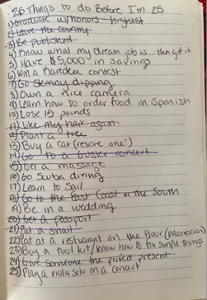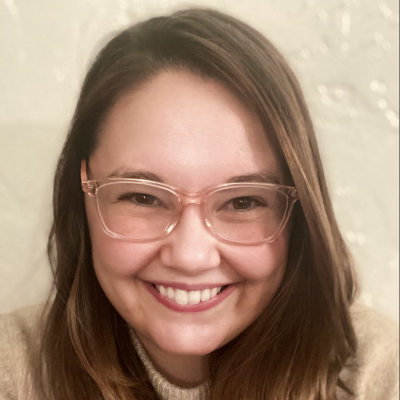12 Reflection: Or, Why My Rambling Thoughts Are Meaningful
Emily Jo Schwaller
The summer before I started college, I changed my major five times. I went from global studies, archeology, anthropology, history of science, all the way to environmental science. The Office of the Registrar knew me by name. I kept looking at the ACT wheel that provided me with potential careers and I just felt lost. It felt wrong that I would base my entire educational career on a one-day standardized test that gave me major anxiety, stress acne, and hives. I also had no idea what jobs would come out of certain majors. What does an anthropologist really do? Is it like Indiana Jones? What if I get a degree and don’t actually enjoy it? Additionally, as someone in charge of paying for college myself, I was nervous about switching majors halfway through and needing to pay for another semester or two.
 At the time I was obsessed with the show, The O.C., about a misunderstood high school “bad boy” who goes and lives with an affluent family in California. In one episode he is starting at a new high school and isn’t sure what classes to take, so the guidance counselor suggests he reflects during each of his classes about what he likes and doesn’t like. I decided to do the same. In doing this exercise I became increasingly nervous I was reflecting in the wrong way. I had bullet points, lists, drawings, half-formed paragraphs. Was this bad? Did it make sense? Had a teacher ever really taught me how to reflect? It was through these questions that I realized what I ultimately cared about was writing and how it gets taught. Once I myself began teaching, I found it essential to include ePortfolios to provide space for intentional reflection so my students could leave knowing they’d been taught how to reflect. Moreover, I wanted to learn about my students and how they make meaning, the questions they ask about their learning, and how reflection becomes part of their lives. ePortfolios allow us to take the messy lists, half-formed thoughts, and drawings and turn them into something useful that tells a larger narrative.
At the time I was obsessed with the show, The O.C., about a misunderstood high school “bad boy” who goes and lives with an affluent family in California. In one episode he is starting at a new high school and isn’t sure what classes to take, so the guidance counselor suggests he reflects during each of his classes about what he likes and doesn’t like. I decided to do the same. In doing this exercise I became increasingly nervous I was reflecting in the wrong way. I had bullet points, lists, drawings, half-formed paragraphs. Was this bad? Did it make sense? Had a teacher ever really taught me how to reflect? It was through these questions that I realized what I ultimately cared about was writing and how it gets taught. Once I myself began teaching, I found it essential to include ePortfolios to provide space for intentional reflection so my students could leave knowing they’d been taught how to reflect. Moreover, I wanted to learn about my students and how they make meaning, the questions they ask about their learning, and how reflection becomes part of their lives. ePortfolios allow us to take the messy lists, half-formed thoughts, and drawings and turn them into something useful that tells a larger narrative.
Eventually, for me, reflection became a habit. I started to reflect on my classes, quotes I read, experiences I had and what I wanted to accomplish. As seen in my “25 Things to Do Before I’m 25” list that I created my sophomore year of college, many of the ideas are not related to coursework but informed the classes I took. I ended up taking courses in Spanish, weightlifting, publishing, and history. During these experiences, I learned more about myself, what motivates my learning, and how to choose classes that align with my personal learning goals. And even though I didn’t accomplish all my goals by 25, it led me in new directions. I also became aware that there are many ways to reflect. I didn’t always want to spend hours doing it but sometimes I could dedicate little pockets of time throughout the day. Some of my reflections were on sticky notes, doodles in my planner, letters in a journal, and some were more tailored to specific topics and audiences.
One of the ways all these reflection types came together was in a project for my PhD program where I reflected on Balinese cooking by creating an ePortfolio. As part of my degree I had to create an ePortfolio of cultural experiences. I had specific goals in mind: I wanted to highlight a learning experience to teach people about Balinese cooking, learn more about myself, and disclose my identity as a white cisgender woman writing about an East Asian community. I anticipated no one would want to read it. Why should they care about my trip? My ramblings? My half-formed thoughts? At first, I was surprised when people in my degree program and my family wanted to ask follow-up questions. I thought it was the beginning of the conversation when in fact the beginning was via the reflection itself. With my portfolio I had started the conversation and then brought people in once I’d identified my own interpretation of the trip’s meaning. By sharing my experience I was inviting people in to share their own stories. I was making space to allow others to share their reflections and celebrate everyone’s stories. I learned about how people cook, places they’ve been, communities they are from, and how these conversations matter. These are stories that sometimes don’t get shared if we believe no one wants to listen. Reflection allows us to value what sometimes is hidden in learning. The quotes we enjoy, the lists of personal priorities, and the stories we tell find space through habitual reflection. I invite you all to read this reflection and begin sharing your own. I look forward to learning with you all!
An ePortfolio is any electronic collection of work that represents the author’s experience, and it can have many functions, such as highlighting exemplary work, providing an overview of qualifications, or showing learning. In the UA General Education program, you will utilize a Learning ePortfolio throughout your Gen Ed courses to reflect upon and make meaning of your learning experiences. This does not mean you can't have other ePortfolios for other purposes. Just like you might create another resume depending on the job application, you might design different ePortfolios for various purposes.


